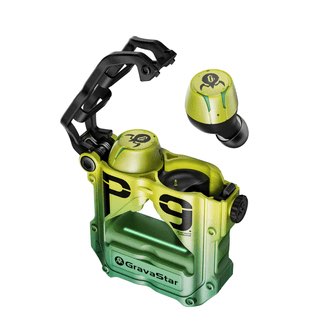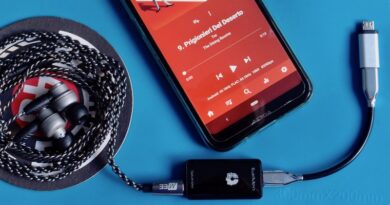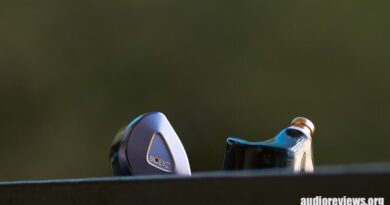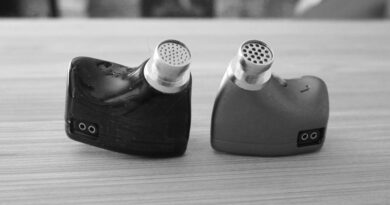Gravastar Sirius Pro TWS Review – Wonderfully Industrial
GravaStar is a US-based workteam founded by an industial designer developing wireless speakers and earbuds putting a strong accent on the aesthetics of their audio products in addition of course to their sonic contents. Their main leitmotiv is “cyberpunk style”. I got a chance to assess their current totl TWS airbud model named “Sirius Pro”, which retails for $149.95.
In this Article
At-a-glance Card
| PROs | CONs |
| Good level of design effort evidently applied on multiple aspects of the product | Not for critical audiophile listening |
| Appealing aesthetics and physical details | Cyberpunk-style design not for “everyone” |
| DSP with 3 preset presentation modes | |
| Very modest latency | |
| Good touch controls | |
| Mic and ENC quality good enough for business calls |
Full Device Card
Test setup
Transports: Samsung smartphone and tablet, two different Windows 10 laptops, Sony NW-A55 DAP – Stock silicon eartips – 16/24bit-44.1/192KHz tracks
Physicals
Build

Sirius Pro TWS’ carry & battery recharge case is very, very nice design-wise, both in terms of aesthetics and of phyisical conception. The shell is fully metallic, with a sort of “unlockable cage” on the upper side safely keeping the buds down in their recharge position. The design follows a very well calibrated cyberpunk style, clearly clinging at such theme lovers but staying a small but decisive step “not too far” on that path, resulting in an item that can still stafely be taken out during an informal business meeting for example.
The metal case is complemented by fancy LED lighting – up to the user selecting their color by cycle-clicking on a button at the bottom, or disabling (!) them – and it’s very uncommon “open-body” shape indeed doubles as a bottlecap opener. Again: strong styles aesthetics design involved, but always with an eye at not really “overexceeding”, the result being still possibly compatible with the taste of an old somewhat conservative old european sole like myself for example. YMMV, needless to say.
I couldn’t devine what material are Sirius Pro TWS’ bud housings themselves made of – the manufacturer talks about zinc-alloy. Whatever, they are apparently very solid, and IPX5 certified which means they can bear moderate watering (like rain, or of course sweat) – no submersion or big water splashes tho so remember that when going to the beach or so.
Sliding the buds out of the battery case gets some… creativity, at least the first times you try. Their backsides are conic shaped and short, and they are almost impossible to safely grab with a fingertip pinch to pull them out both due to their shape & size and to the magnetic force applied between them and the case. The trick at least for me is to start pinching on the case (!) right below where the buds start emerging from it, and pull up while letting fingertips slide on the structure: this way they come out easilly and aergonomically as (I suppose) intended.
Access to the battery case is regulated by a metal “gate” which besides being aestheticall in-line with the overall style also serves the function of keeping the two buds safely into their case when pocketing them, and last but not least ensuring their bottomside contacts do fully match those on the receptacles, to initiate recharging when the buds are homed.
Fit
Sirius Pro TWS bud shells are very reasonably lightweight and their shape is quite anatomical. They fit easily into my ears but be warned: they need to be orientated the “right” way. Simply put, you have to make sure the “octopus legs” are pointing towards your lobe, and this for two reasons: one to get the best fit of course and two to avoid the mic hole being occluded. This is also properly mentioned on the manual (RTFM, FFS! 🙂 )
Nozzles are oval shaped (à la Ikko OH1S, to give an idea) so are the bundled eartips. I must say this is one of those rare occasions where stock tips are perfect for the job. Caveat: it may be not so simple finding third party spares.
Comfort
Once properly fitted I found Sirius Pro TWS very comfy, also for prolonged usage timeframes – both listening and/or office calls. I presume this is another achievement coming from all the industrial design attention which was obviously applied to this project and product.
Tapping once on more on the housings allows the user to issue the usual commands e.g. track fwd, track backwards, play, pause, answer call, reject call, etc. Tunneling voice commands to Android assistant is also supported.
Connectivity and battery
Sirius Pro TWS support Bluetooth 5.2, but sadly only SBC and AAC codecs. No aptX, no LDAC. So forget hi-res audio in the first place with them, although as I will report more below that’s not their worse audio drawback.
Pairing with all the transports I tried them with was straightforward, no annoying bad surprises. Long-clicking the button at the bottom of the batterycase resets all BT pairing by the way.
The buds themselves turn ON when take off the battery case, and OFF when put back in. After pairing the two to a given source, they can be used together or one at a time as preferred – just leaving one of the two inside the case.
The battery-case on its turn has a USB-C port for recharging of course.
The small batteries inside the buds offer up to 4 hours of operation time, and the case can fully recharge them for 3 times, up to a theoretical autonomy of 16 hours. But : earbuds take 1.5/2h to recharge ! So if you imagine to use them continually until they are fully discharged you will have to bear a quite sizeable downtime every 3.5/4h. In more practical terms you can expect to use Sirius Pro TWS for more than a full working day (including even long commuting time) for calls, and for listening to music during free time, as long as you take them off into their case for a while every now and then to restore some juice up.
Sound analysis
As all TWS earphones/headphones, Sirius Pro of course carry their own small DAC-AMP which is in charge of analog reconstruction starting from the digital stream received via BT. Barred a few very high end (and expensive) cases, the overwhelming majority of budget-priced TWS drivers carry quite basic-quality DAC-AMP circuitry, from which of course we can’t reasonably expect top sonic results.
Sirius Pro TWS are no exception. Simply put, they offer some pleasant music rendering experience when evaluated under “non-audiophile” standards, while – like most of their peers – they fall way behind critical listening / audiophile quality standards offered by even more modestly priced wired options.
Sirius Pro TWS also carry some DSP capabilities offering the user 3 pre-set audio modes – Music, Gaming and Movie – each offering a different overall presentation which the user can switch onto on the fly by simply tapping on the buds’ housings.
Music Mode
Music Mode is probably the zero-DSP mode, i.e. the situation where I am direct listening to the unaltered Sirius Pro DAC voicing.
Tonality on Music Mode is V shaped, on a warm, dark-ish timbre.
Bass range is moderately extended, sub bass is hinted but does not deliver proper rumble. Midbass is pushed up, and too much proactive for acoustic music where it comes accross almost booming. May be liked by EDM and other non-acoustic music lovers.
Mids are evidently recessed and seriously overshadowed by the midbass. Highmids are also quite timid so even on female vocal prominent tracks the ryhtm section steals the scene to the leader. Trebles are inoffensive and unshrilling, at least that, but (quite coherently with the rest of the presentation) they clearly lack air thereby not succeeding in properly “counterbalancing” the overall experience.
Technicalities are very basic. Soundstage is intimate, with just a bit of depth. Imaging is hampered by the midbass. Microdynamics are nowhere near audiophile ballparks.
Gaming Mode
Gaming mode evidently expands the soundstage, a distributes imaging better on the X axis at least.
Midbass gets less invasive which makes at least female vocals come up more natural.
Movie Mode
Movie mode delivers a stage similar to the gaming one, and stretches (so to say) bass similarly too, so midbass is also less invasive, which is good of course.
The less good part is that mids are pushed forward and end up quite artificial from the sound fidelity perspective. Good for watching movies (as intended!), not for listening to folk singers nor jazz or most pop stuff of course.
Latency
Latency is very modest, and simply put it does not get in the way any seriously when watching movies. And that’s good.
While gaming… well, it depends on gaming levels. I expect an hardcore FPS gamer to underline the ever so slight delay Sirius Pro TWS deliver, but then again that individual would probably not choose a similar pair of TWS buds for his most engaging plays anyway.
Calls
I could quite successfully use Sirius Pro TWS for business calls, and I was very positively surprised by that.
As previously mentioned, it’s crucial to appropriately orientate the housings into the ears to get the best fit and properly expose the mic’s hole (again: RTFM). When that is taken care of, mic quality and Environment Noise Cancellation (ENC) is above decent at the very least – not comparable with professional vertical products of course, but way beyond usable.
On calls I ended up preferring Sirius Pro TWS on Gaming mode in terms of vocal quality.
Specifications (declared)
| Housing | Zinc-alloy housings, IPx5 certified. Full metal charging case (not waterproof). |
| Driver(s) | 1 x 7.2mm dynamic driver + 1 x Knowles balanced armature driver |
| Connectivity | Bluetooth 5.2 – SBC, AAC codecs. 65ms latency. 10m range |
| Battery | 4h battery life, 1.5/2h recharge time for the buds. 3 full earbuds recharges (400mAh LI-ion), 3h+ recharge time for the case. |
| Accessories and package | One set S/M/L oval silicon tips, USB-C battery case recharge cable, Plastic outer packaging box, Hip-hop style metal necklace |
| MSRP at this post time | $149.95 |
| Purchase link | https://www.gravastar.com/products/sirius-pro-earbuds |
| Discount code (16% off): AUDIOREVIEWS (not an affiliate link) |
Considerations & conclusions
TWS earphones are no doubt a huge technical challenge in terms of achieving true audiophile results, comparable with wired alternatives.
Firstly, there ain’t such thing as “lossless BT communication” so that is an apriori negative bias no matter what technology or competence goes into the buds themselves.
Even more importantly, by definition TWS earphones must carry their own DAC-AMP. Think to how much did you spend for your DAC and your AMP, and/or for your DAP, add the cost of your preferred IEMs, then compare that with the budget you are investing into a pair of TWS IEMs : this will give you a rough measure of the expectations you may reasonably set in terms of output quality from TWS buds.
Indeed, it’s even worse than that: earbuds are small. The smaller the size, the more complicated (and sometimes impossible) it is to fit truly high quality DAC and especially AMP technology in.
With all the above in mind, looking at their asked price Gravastar Sirius Pro TWS are a wonderful piece of industrial design in terms of construction, ergonomics, features set and not least aesthetics (although carrying a definitely sided style at that). On the flip side they evidently lag behind in terms of pure hires sound reproduction quality – which I quite simply rate “no audiophile grade” – and make themselves more appreciated as a multipurpose music, office calls, gaming, movie watching audio gadget instead.
The Sirius Pro TWS set I assessed have been provided free of charge by Gravastar Europe, to whom my thanks goes for the consideration and the trust. They can be purchased from Gravastar web site, here. 16% off with discount code AUDIOREVIEWS.
Our generic standard disclaimer.








This Gravastar Sirius Pro TWS review offers a thorough evaluation of the product, highlighting its strengths and weaknesses with clarity. As someone considering investing in wireless earbuds, I found this review incredibly helpful in making an informed decision. The detailed analysis of sound quality, design, and battery life provides valuable insights. Thanks for sharing your thoughts on the Gravastar Sirius Pro TWS!